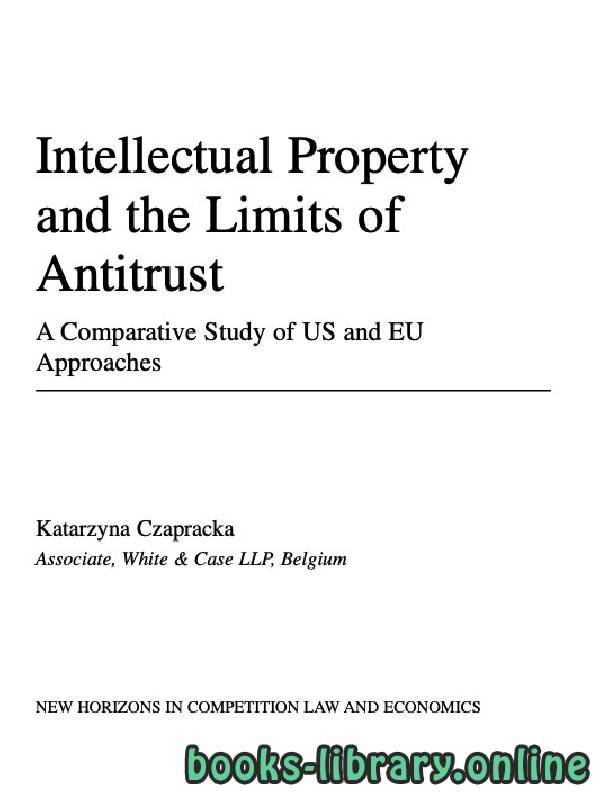📘 قراءة كتاب Intellectual Property and the Limits of Antitrust أونلاين


تعريف القانون باللغة الانجليزية
كلية القانون بالانجليزي
تعريف القانون العام بالانجليزي
كتابة كلمة قانون بالانجليزي
تخصص قانون بالانجليزي
محامي بالانجليزي
ترجمه القانون بالانجليزي
قانوني بالانجليزي
القانون الانجليزي pdf
مادة مصطلحات قانونية باللغة الانجليزية
تحميل كتاب مصطلحات قانونية باللغة الانجليزية pdf
تحميل قاموس قانوني عربي انجليزي pdf
معجم القانون pdf
مصطلحات القانون الجنائي باللغة الانجليزية
جميع الكلمات القانونية باللغة الانجليزية
تعريف القانون باللغة الانجليزية
This book strives to offer a better understanding of the roots of the differences in the application of antitrust principles to IP rights. It focuses on unilateral conduct and on cases where antitrust remedies deprive the right owner of
exclusivity, the core of an IP right. This area merits special attention for two
reasons. First, it is the source of the greatest differences in the approaches of
EU and US antitrust enforcers to IP rights. Second, it is the area where the
application of antitrust rules to IP rights can have the direst consequences for
the right holders.
Whereas the scope of antitrust laws has been shrinking in the United States,
EU competition law has been consistently used to regulate a number of issues
that are considered to be outside the scope of the Sherman Act. In the United
States, unilateral conduct involving exercise of a valid IP right can hardly give
rise to liability under antitrust rules and antitrust authorities have been reluctant to intervene in what is perceived to be the sphere of IP policy. In contrast,
the EU antitrust enforcers have been much more active than their US counterparts in addressing the consequences of what they perceive as imperfect IP
laws, thus reshaping the substantive standards for IP protection. In a few cases
involving difficult questions relating to the scope of IP rights, the Commission
and the EU courts have ruled that, in limited circumstances, a dominant
company may violate Article 82 by refusing to license a valid IP right to its
competitors. Allocation of the burden of proof is also significant. For example,
in the recent Microsoft ruling, the CFI required that the dominant company
submit evidence showing that compulsory licensing would have ‘a significant
negative impact on its incentives to innovate’ in order to justify its refusal to
share its IP with competitors.11 At the same time, it appears that the Court was
satisfied that a compulsory license would stimulate follow-on innovation on
the basis of less concrete evidence than was required in previous compulsory
licensing cases.
One reason for these divergences is that EU and US courts assess market
power and its abuse quite differently. Monopolization under §2 of the Sherman
Act and an abuse of a dominant position under Article 82 of the EC Treaty
comprise two elements: possession of market power and anticompetitive
conduct. Yet, there are major differences between the EU and US rules relating,
for example, to the definition of dominance, the assessment of what constitutes
anticompetitive conduct, and the requirement of a causal link between maintenance of monopoly power and anticompetitive conduct. Whereas §2 of the
Sherman Act is designed to protect competition by prohibiting the acquisition
or maintenance of ‘monopoly power’, Article 82 is used to regulate the actions
of companies in ‘dominant positions’. One of the principles repeated in EU
يسعى هذا الكتاب إلى تقديم فهم أفضل لجذور الاختلافات في تطبيق مبادئ مكافحة الاحتكار على حقوق الملكية الفكرية. وهو يركز على السلوك الانفرادي وعلى الحالات التي تحرم فيها سبل الانتصاف من مكافحة الاحتكار المالك المناسب لها
التفرد ، جوهر حق الملكية الفكرية. هذا المجال يستحق اهتماما خاصا لمدة سنتين
الأسباب. أولا ، هو مصدر أعظم الاختلافات في نهج
الاتحاد الأوروبي والولايات المتحدة مكافحة الاحتكار يفرض على حقوق الملكية الفكرية. ثانيا ، هو المجال الذي يوجد فيه
يمكن أن يكون لتطبيق قواعد مكافحة الاحتكار على حقوق الملكية الفكرية عواقب وخيمة على
أصحاب الحق.
في حين أن نطاق قوانين مكافحة الاحتكار يتقلص في الولايات المتحدة ،
وقد تم استخدام قانون المنافسة في الاتحاد الأوروبي باستمرار لتنظيم عدد من القضايا
التي تعتبر خارج نطاق قانون شيرمان. في الولاية
الدول ، والسلوك الانفرادي الذي ينطوي على ممارسة حق IP صحيح لا يكاد يعطي
يرتفع إلى مستوى المسؤولية بموجب قواعد مكافحة الاحتكار وترفض سلطات مكافحة الاحتكار التدخل في ما يُعتبر مجال سياسة الملكية الفكرية. فى المقابل،
كان القائمون بإنفاذ قوانين مكافحة الاحتكار في الاتحاد الأوروبي أكثر نشاطًا من نظرائهم في الولايات المتحدة في معالجة عواقب ما يعتبرونه IP غير كامل
القوانين ، وبالتالي إعادة تشكيل المعايير الموضوعية لحماية الملكية الفكرية. في حالات قليلة
تنطوي على أسئلة صعبة تتعلق بنطاق حقوق الملكية الفكرية ، اللجنة
وقد قضت محاكم الاتحاد الأوروبي ، في ظروف محدودة ، بالهيمنة
قد تنتهك الشركة المادة 82 برفضها ترخيص حق IP صالح لها
المنافسين. تخصيص عبء الإثبات مهم أيضاً. فمثلا،
في حكم مايكروسوفت الأخير ، تطلبت CFI من الشركة المهيمنة
تقديم أدلة تثبت أن الترخيص الإجباري سيكون له أهمية
تأثير سلبي على حوافزها للابتكار من أجل تبرير رفضها
مشاركة عنوان IP الخاص به مع المنافسين .11 وفي الوقت نفسه ، يبدو أن المحكمة كانت
مقتنع بأن الرخصة الإجبارية من شأنها أن تحفز الابتكار على المتابعة
أساس أدلة ملموسة أقل مما كان مطلوبا في السابق إلزامي
حالات الترخيص.
أحد أسباب هذه الاختلافات هو أن محاكم الاتحاد الأوروبي والولايات المتحدة تقيم السوق
السلطة وسوء المعاملة بشكل مختلف تماما. الاحتكار بموجب الفقرة 2 من شيرمان
التصرف وإساءة استخدام المركز المهيمن بموجب المادة 82 من معاهدة الاتحاد الأوروبي
تتألف من عنصرين: امتلاك القوة السوقية والمنافسة
سلوك. ومع ذلك ، هناك اختلافات كبيرة بين قواعد الاتحاد الأوروبي والولايات المتحدة المتعلقة ،
على سبيل المثال ، لتعريف الهيمنة ، وتقييم ما يشكل
السلوك المضاد للمنافسة ، وشرط وجود صلة سببية بين الحفاظ على قوة الاحتكار والسلوك المضاد للمنافسة. في حين أن الفقرة 2 من
تم تصميم قانون شيرمان لحماية المنافسة من خلال حظر الاستحواذ
أو الحفاظ على "سلطة الاحتكار" ، وتستخدم المادة 82 لتنظيم الإجراءات
الشركات في "المراكز المهيمنة". أحد المبادئ المتكررة في الاتحاد الأوروبي
سنة النشر : 2009م / 1430هـ .
نوع الكتاب : pdf.
عداد القراءة:
اذا اعجبك الكتاب فضلاً اضغط على أعجبني و يمكنك تحميله من هنا:

شكرًا لمساهمتكم
شكراً لمساهمتكم معنا في الإرتقاء بمستوى المكتبة ، يمكنكم االتبليغ عن اخطاء او سوء اختيار للكتب وتصنيفها ومحتواها ، أو كتاب يُمنع نشره ، او محمي بحقوق طبع ونشر ، فضلاً قم بالتبليغ عن الكتاب المُخالف:
 قبل تحميل الكتاب ..
قبل تحميل الكتاب ..
يجب ان يتوفر لديكم برنامج تشغيل وقراءة ملفات pdf
يمكن تحميلة من هنا 'http://get.adobe.com/reader/'


 منصّة المكتبة
منصّة المكتبة